On Location – Three Colors: Red – Three Colours: Red
Revisiting ‘Trois Couleurs: Rouge’ – a Tribute to Krzysztof Kieślowski
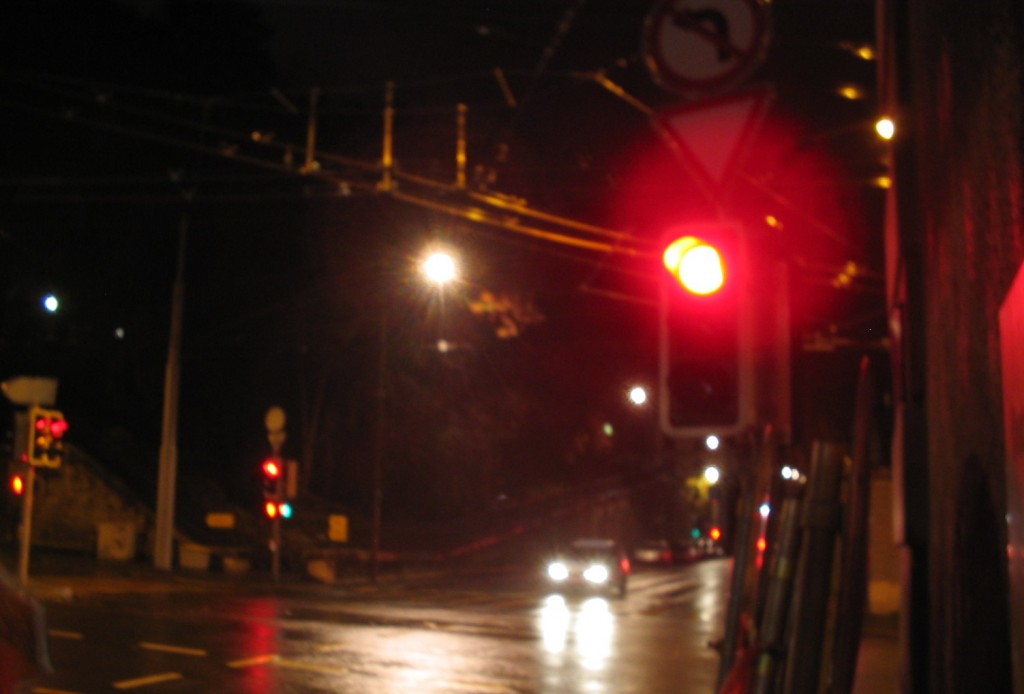
Place des Casemates
Preamble
The third and final film of Kieslowski’s Three Colours trilogy, Red (Trois Couleurs: Rouge), is one of my favourite films of all time. The entire trilogy, and especially Red, has affected me profoundly in multiple ways: visualising and shaping my aesthetic preferences [crude example: it’s at the back of my mind when taking photographs of urban landscapes; subtler example: it gives us food for thought, if not a manual, for a European identity and our cultural language], as well as capturing and expressing questions for which I’ve always had an instinctive fascination. The overall metaphor or “brief” of the trilogy was to apply the three core values of the French revolution and building blocks of European enlightenment (Freedom – Blue, Equality – White, Fraternity or Brotherhood – Red) to contemporary Europe (France, Poland and Switzerland respectively). Social alienation and altruism; technological dependence and voyeurism; the hope, energy and dreams of youth versus the regrets, fatigue and pessimism of old age; and, above all, love and forgiveness.
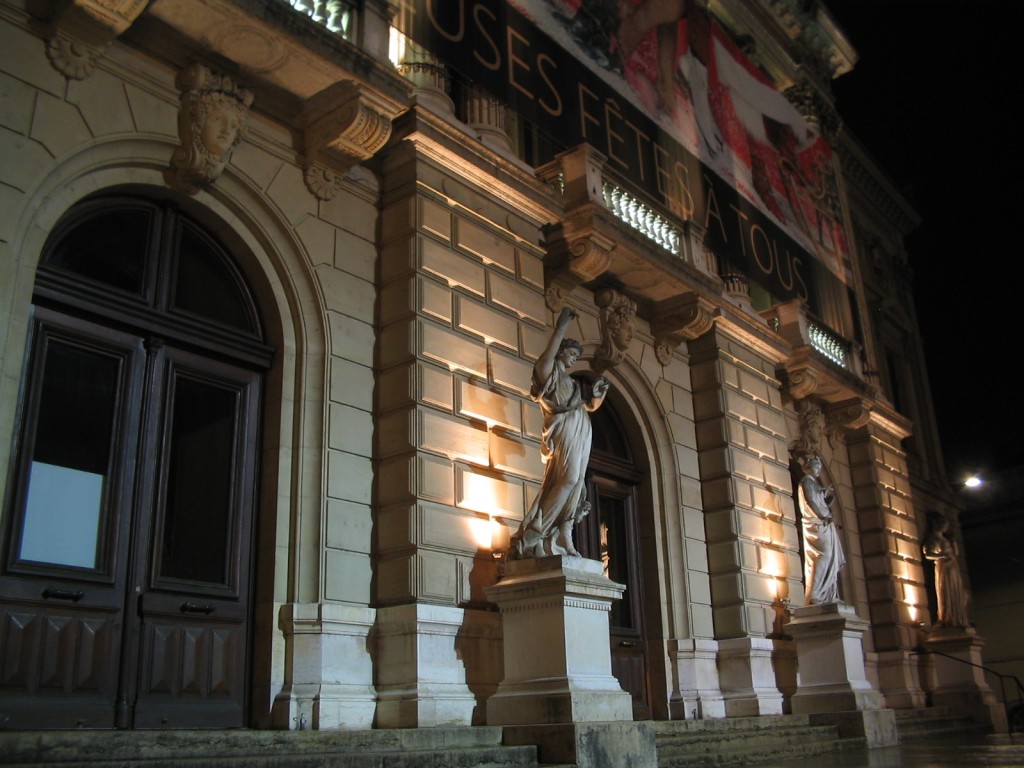
Grand Théâtre de Genève
One of the fascinating things about watching the Three Colours trilogy again and again is the amount of new layers, symbolisms and possible readings that one can extract from these cinematic texts, which I feel will endure for a very long time to come. I was lucky enough to grow up in a city (Athens) which has persistently promoted and distributed quality European films. Watching Blue and Red at the time of their original release back in 1993 and 1995 [I admit not watching White until much later] was also a formative experience in film-going terms, by making me fall in love with a type of European cinema, which some call “art house” – I call it cinema that respects both itself and the viewer; films that challenge you, but also comfort you by providing you with the aesthetic vocabulary, ideals or values that our contemporary society so desperately lacks. For some reason I’ve never really enjoyed (literary) poetry (it just doesn’t “do” it for me – or perhaps I don’t “get” it), but perhaps surprisingly, I love the cinematic poetry of Kieslowski or, for example, Angelopoulos – perhaps because I can relate to it in various historical or cultural ways.
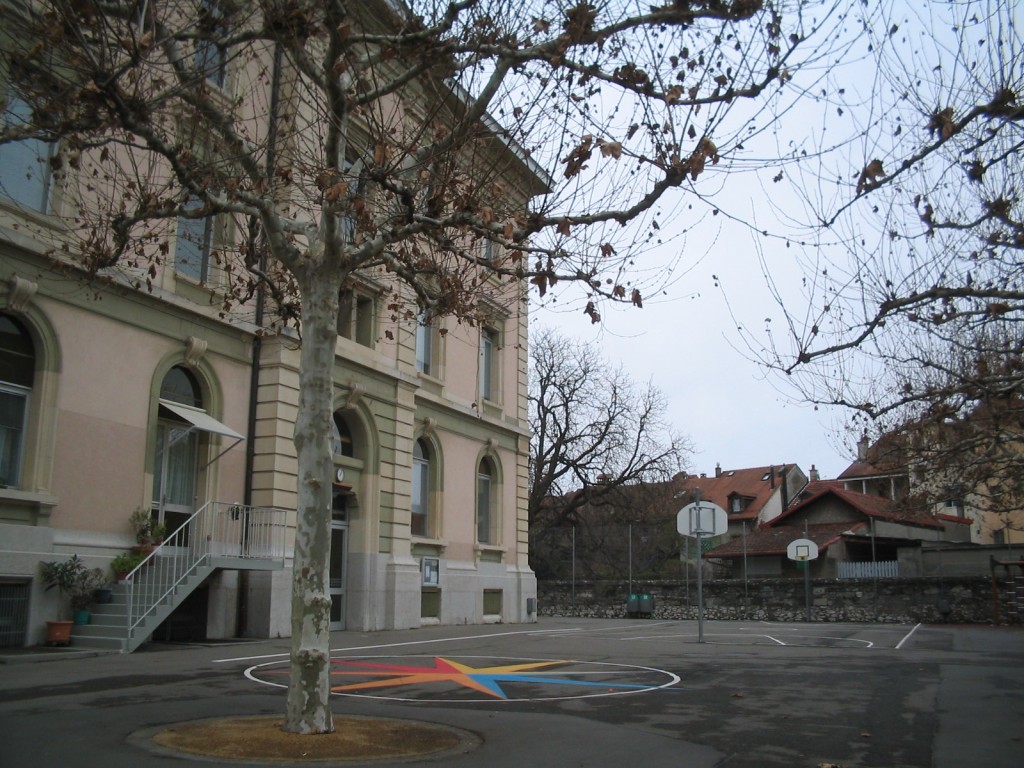
Carouge
A lot has been written by film critics, scholars, students and fans about Kieslowski’s work and about Red in particular [check out the reading list below for some recommendations]. However, Kieslowski firmly believed in the role of the audience – considering the viewer as a partner in the process of realisation. One gets the sense that he was driven by a subtle but persistent passion and also by a clear and pressing vision, which he materialised through painstaking attention to detail throughout the film-making process. Still, he refused to lead viewers to a specific interpetation of specific stylistic choices or narrative techniques. [“I don’t believe in cinema, I only believe in the audience” Kieslowski at an interview he gave during the 1994 Cannes Film Festival].
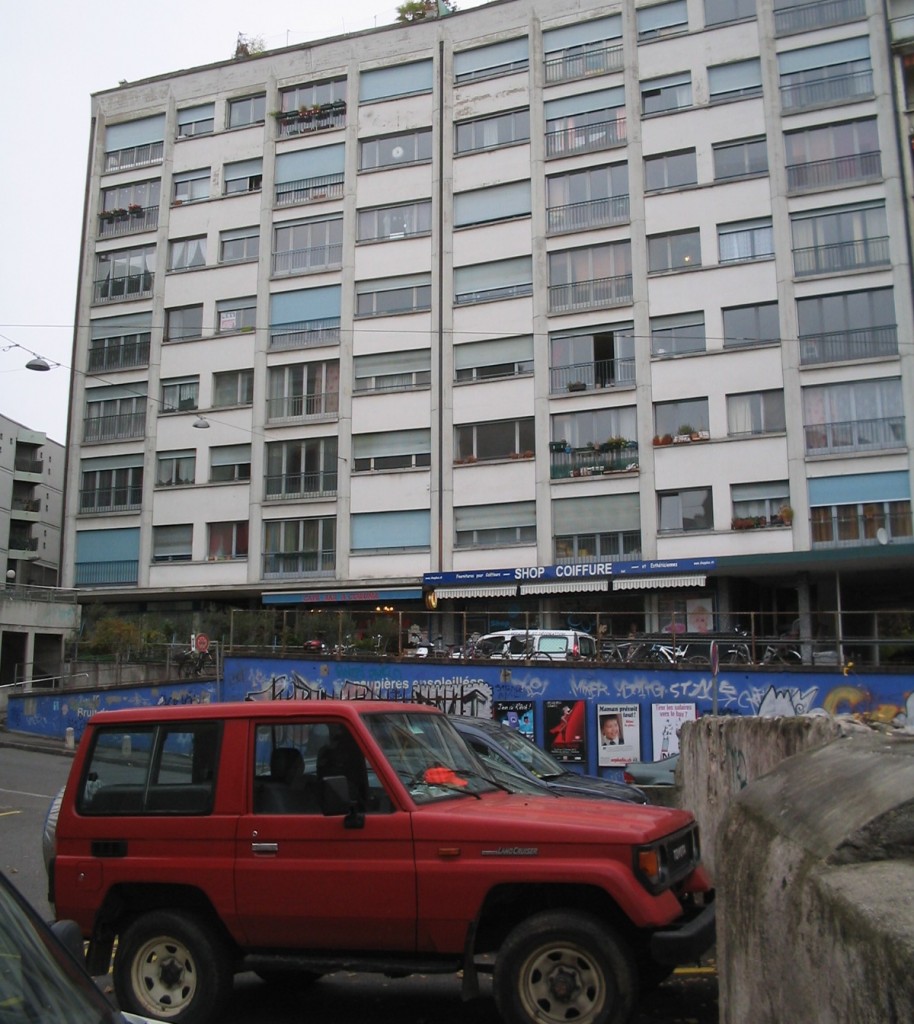
Passage de Saint Francois
This online exhibition is both a labour of love and a dream come true, as it’s something I’ve wanted to do for many years. For this photo-essay I tracked and captured some of the main filming locations of Trois Couleurs: Rouge in Geneva, as identified through research and repeated viewings of the film and of the DVD extras (which I strongly recommend for all fans of the film and of Kieslowski’s work). I present locations in the order in which they first appear in the film. This exhibition would not have been possible without the help of Alexandre Fabbri, whose excellent website, Kieslowski’s World, is by far the best and most comprehensive online resource on Kieslowski’s films. It goes without saying that any errors or omissions are entirely my own, and this photo-essay is by no means exhaustive of the actual filming locations.
1. Valentine’s Flat, Auguste’s Flat and Café Chez Joseph (corner of Rue des Sources and Rue Micheli du Crest)
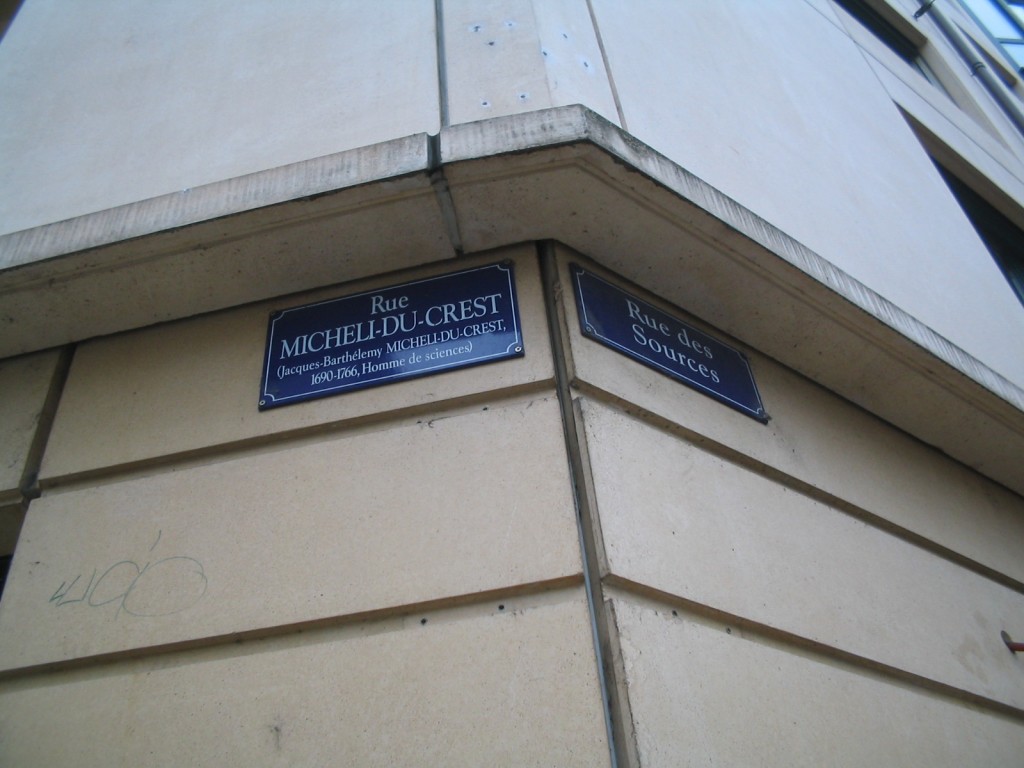
The corner of Rue des Sources and Rue Micheli-du-Crest (which, for some reason, on Google Maps appears as Rue Gabrielle-Perret-Gentil). This is the precise spot where Café Chez Joseph and, above it, Valentine’s flat were located. That old building has now been replaced by a new block of flats.
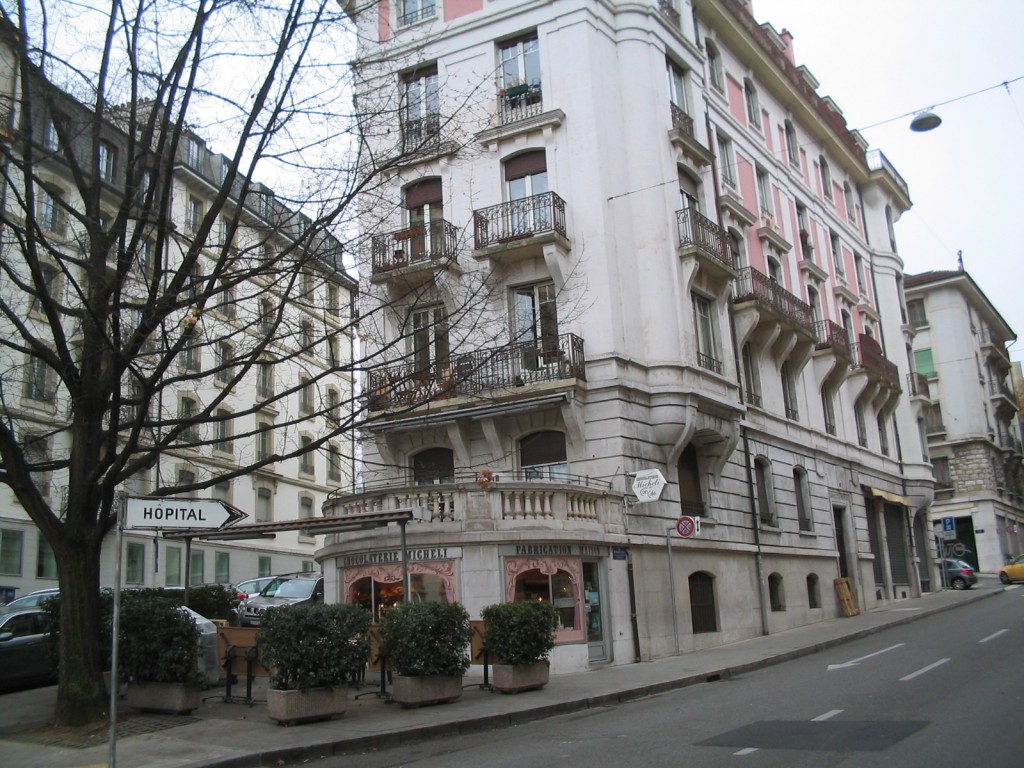
Rue Micheli-du-Crest and (in the background on the right, at the junction with Rue des Sources) the – intact – building which housed Auguste’s flat, directly opposite Valentine’s flat and Café Chez Joseph).
“On Red, we had an enormous problem. We needed a set which had in it both Irène Jacob’s flat and the flat of the young man who lived opposite. Using a very complicated camera on a crane, which was very rarely used in France or in Europe at the time, we had to be able to follow each of them walking around and returning to Irène Jacob’s flat. We found the ideal spot so we wouldn’t need a studio reconstruction. […] In that way we managed to achieve a studio-type set in the middle of Geneva. It should have been built in a studio but it wouldn’t have been so good. The link with reality meant it was good in the streets, the natural light was good, having the real set was good. Having this set gave [Kieslowski] some ideas, so economy had to be sacrificed so that this set could be used. But it was good for the film”. [Marin Karmitz, producer of Trois Couleurs: Rouge, in the DVD extras].
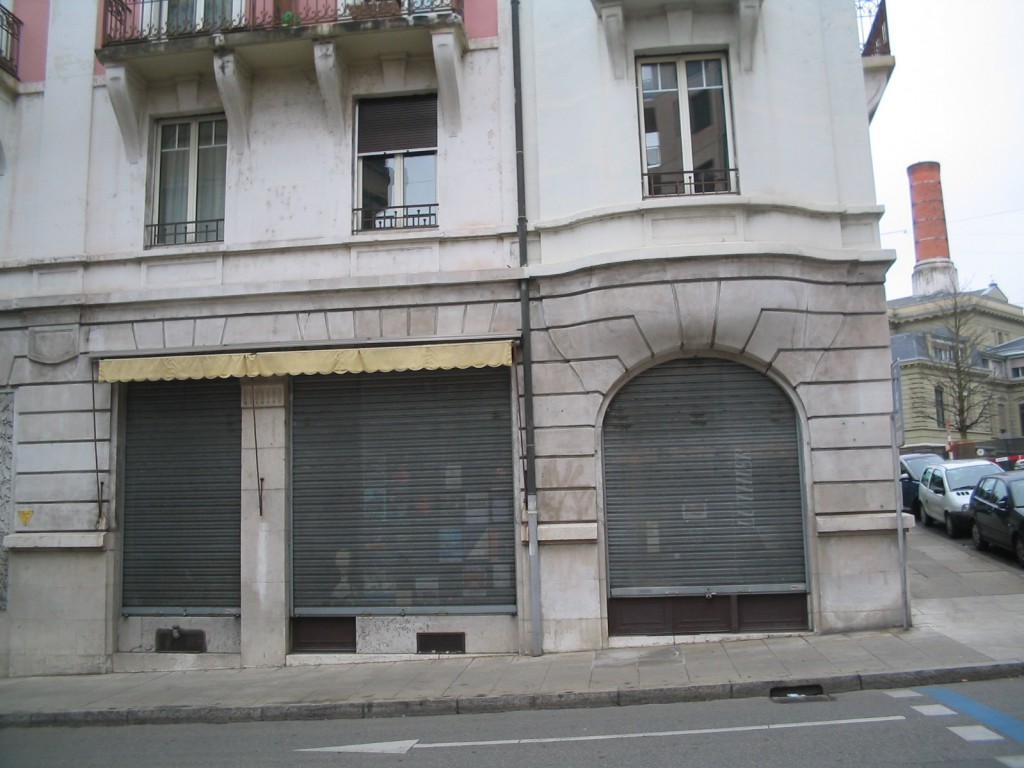
The opposite corner of Rue des Sources and Rue Micheli-du-Crest facing both Valentine’s flat on one side and Auguste’s flat on the other. That building hasn’t changed at all and appears throughout the film (easily recognisable by its red blinds) as Auguste usually parks his red Jeep just outside.
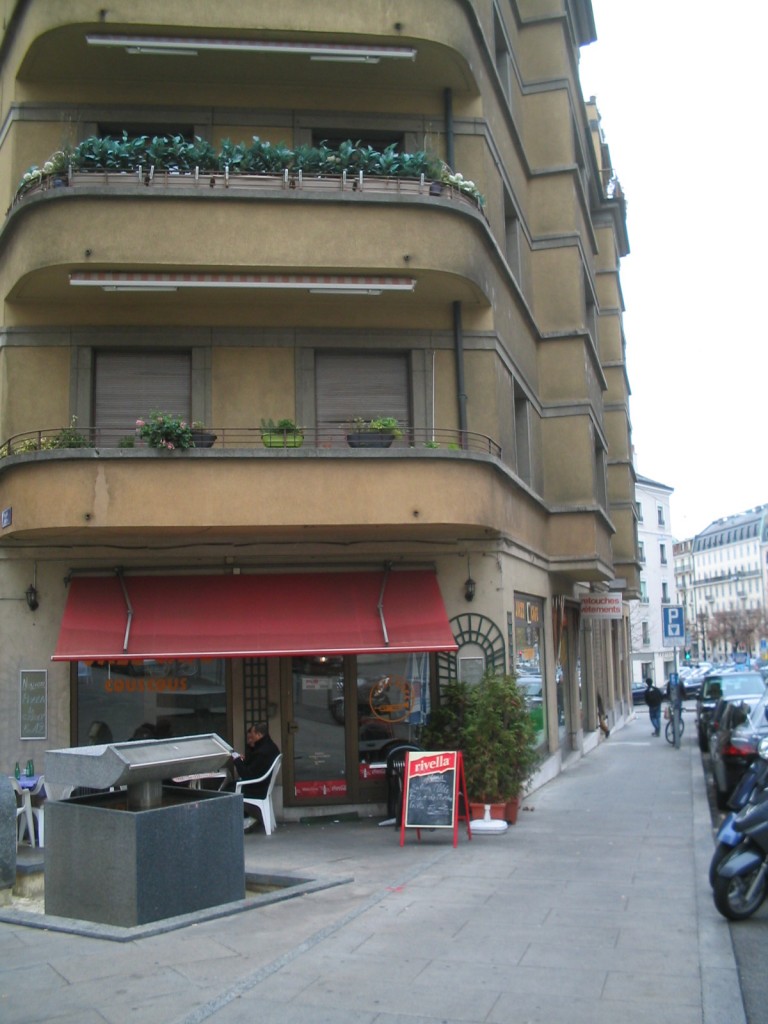
The shop at the (opposite) corner of Rue des Sources and Rue Micheli-du-Crest, which was facing Café Chez Joseph and appears at several points in the film (including the scene in which Auguste drives over the curb in order to do a quick U-turn). That side of the corner hasn’t changed much.
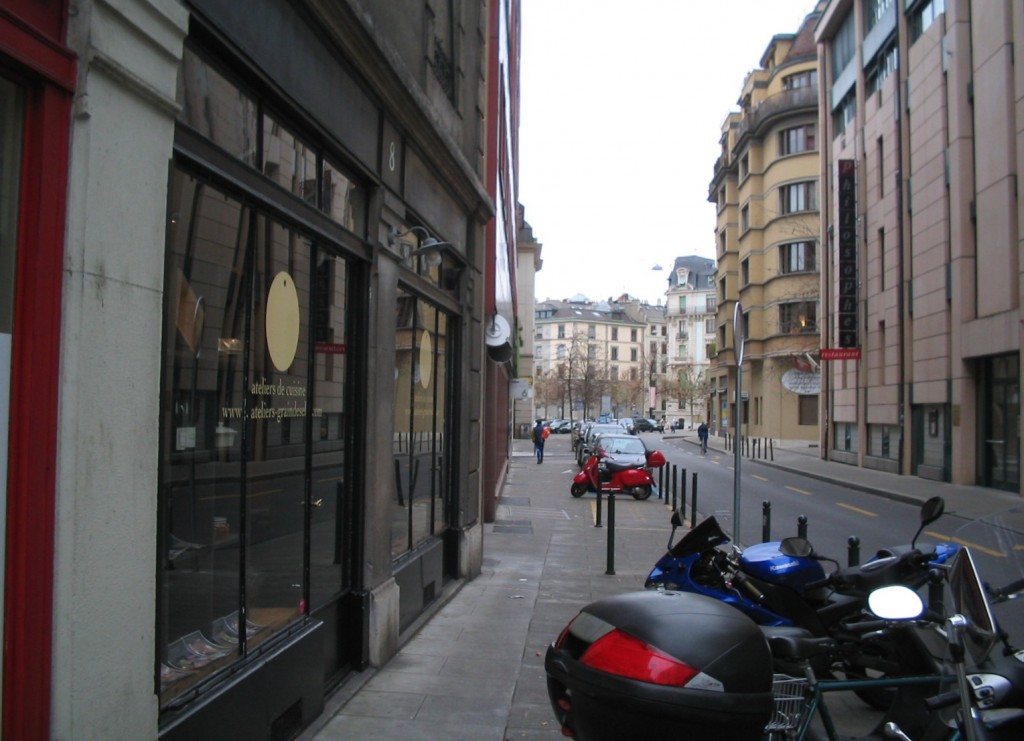
The (renovated) Restaurant des Philosophes at Rue Prévost-Martin. The restaurant is next to the building of Valentine’s flat / Café Chez Joseph in Rue des Sources, and features at several points in the film, e.g. when Valentine enters or exists Café Chez Joseph. The old building of the restaurant has disappeared – as has the large sign – but Les Philosophes is still situated there in a slick new building with a new logo.
2. Valentine after the (first) Fashion Show, in the car, drives by the river at the Quai des Bergues (?)
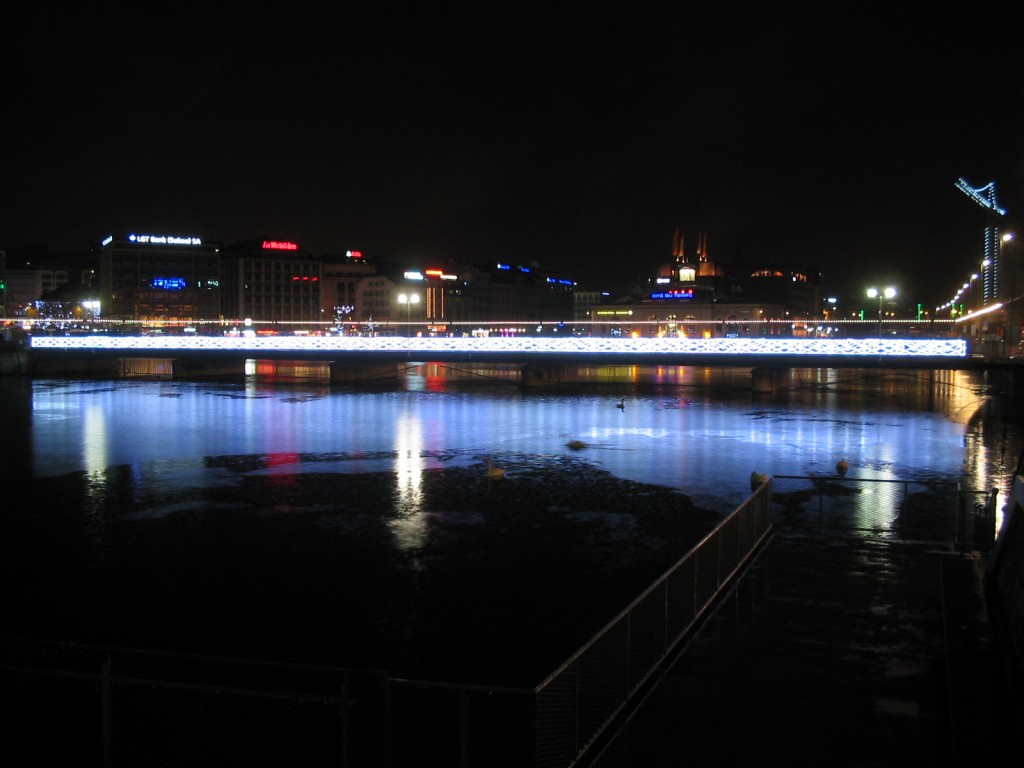
The Rhone by the Quai des Bergues.
3. Valentine drives by the Place des Casemates while Auguste drops his books
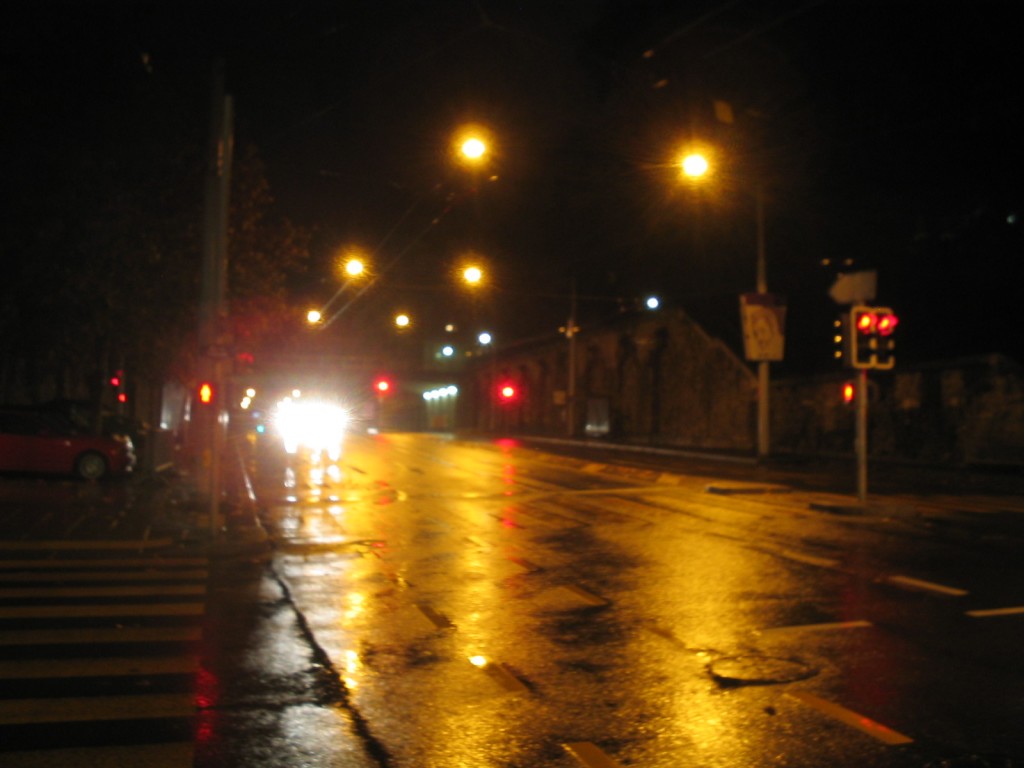
The corner of Place des Casemates and Boulevard Emile-Jaques-Dalcroze, which is one focal locations of the film (only a few blocks away from Valentine’s flat). Valentine waits at the red light here and then drives off while Auguste drops his law books.
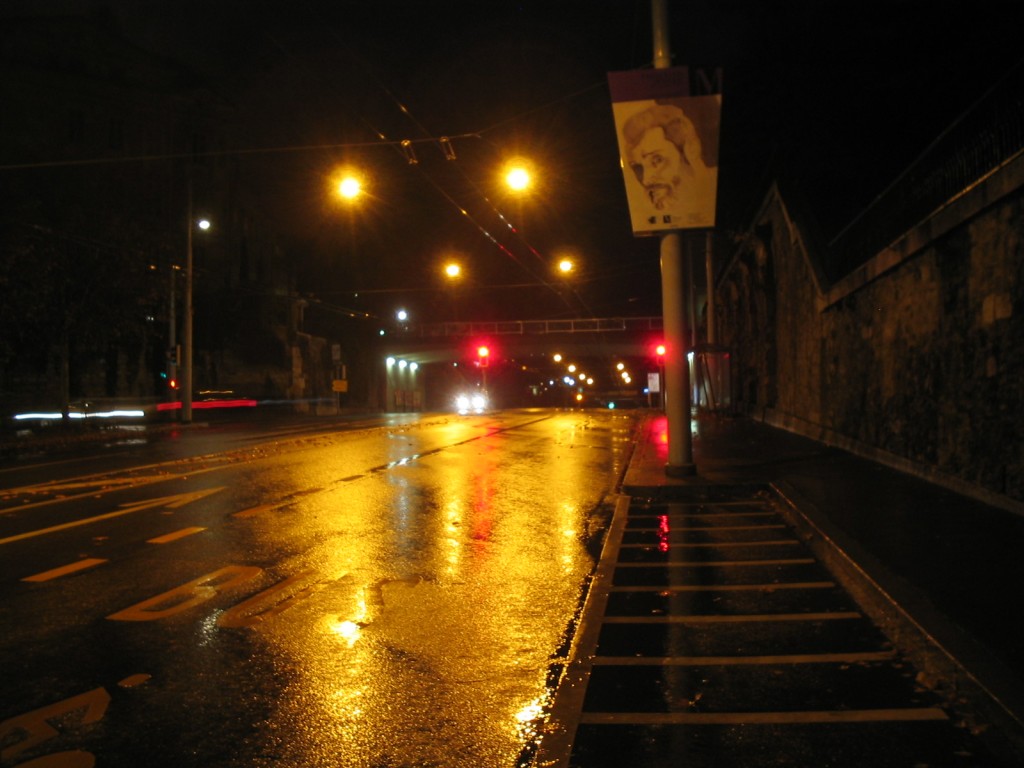
As Valentine drives away we see on the wall (right) the scaffolding for the huge poster that is placed there later in the film.
“For me Red was a completely overwhelming experience, because I filmed it in Geneva, where I’d grown up. I’d left Geneva at about 18, with no desire to return, and returning with this film overwhelmed me. Being able to come back and revisit something, but this time with a film that I loved, doing work that I loved, that was really amazing” [Irène Jacob talks about Red – in the DVD extras, 2001].
4. Retired judge Joseph Kern’s house at 6 Chemin Fillion in Carouge
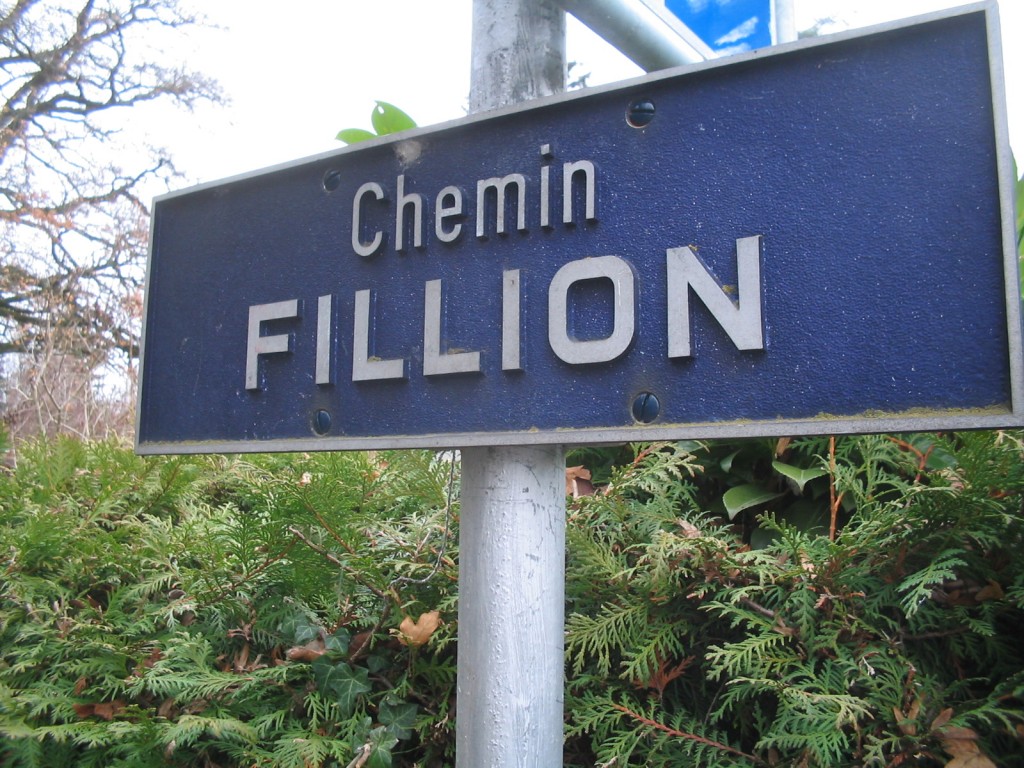
Chemin Fillion in Carouge – the street in which the judge (Jean-Louis Trintingant) lives, and spies.
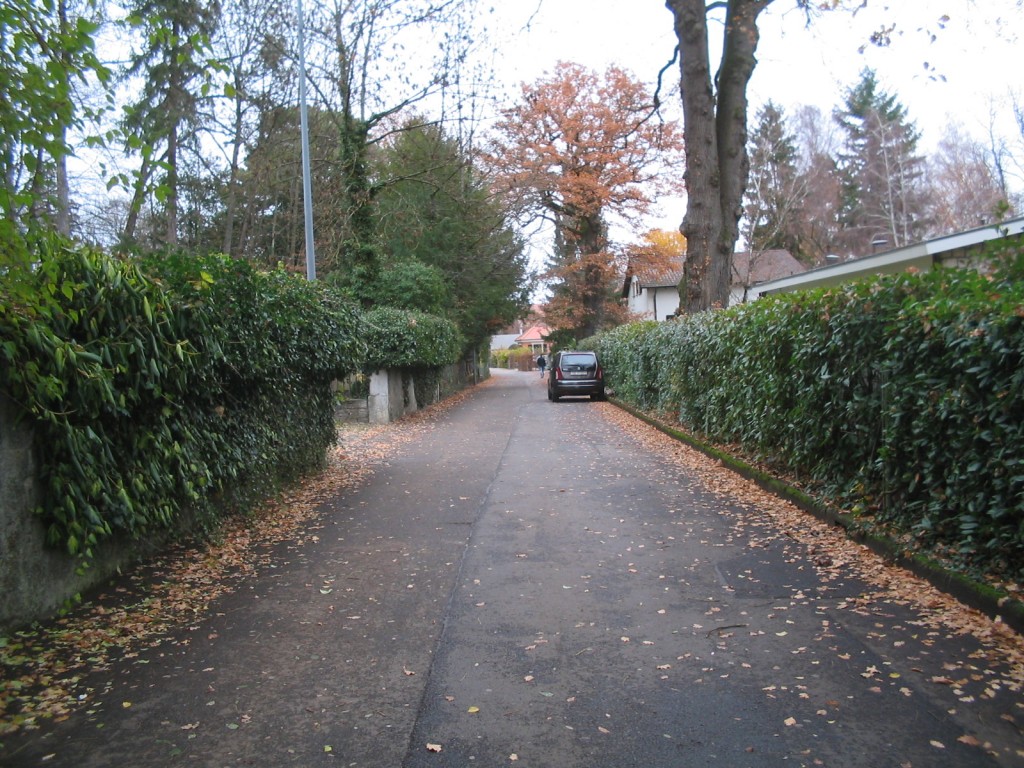
Chemin Fillion in Carouge.
“It’s a meeting between experience, disappointed experience, and the beginning of life, with all its hopes and possibilities. There was some very strong dialogue and Krzysztof himself felt very close to it. He wanted to express it through these different characters. It revisited a time when everything is possible, when you don’t know what you want out of life. Afterwards comes disappointed experience, the place you finally end up.” [Irène Jacob, ibid.].
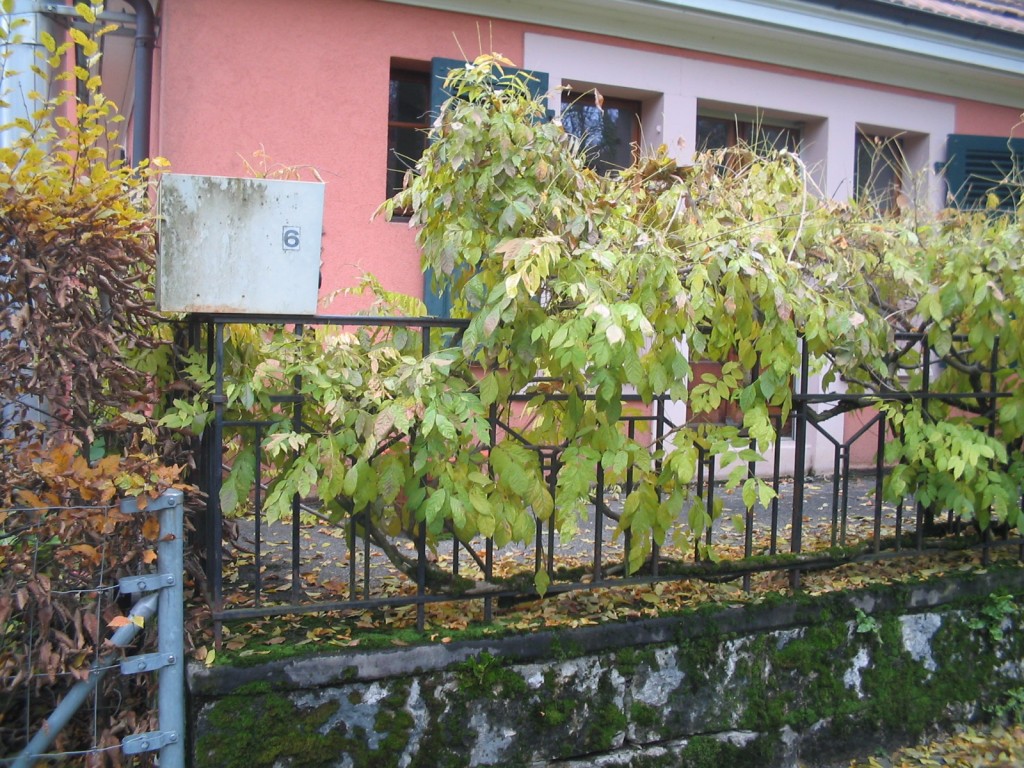
6 Chemin Fillion in Carouge where judge Joseph Kern lives. The house situated there today looks and feels quite different from that featuring in the film and it’s likely that some building work has taken place since 1993.
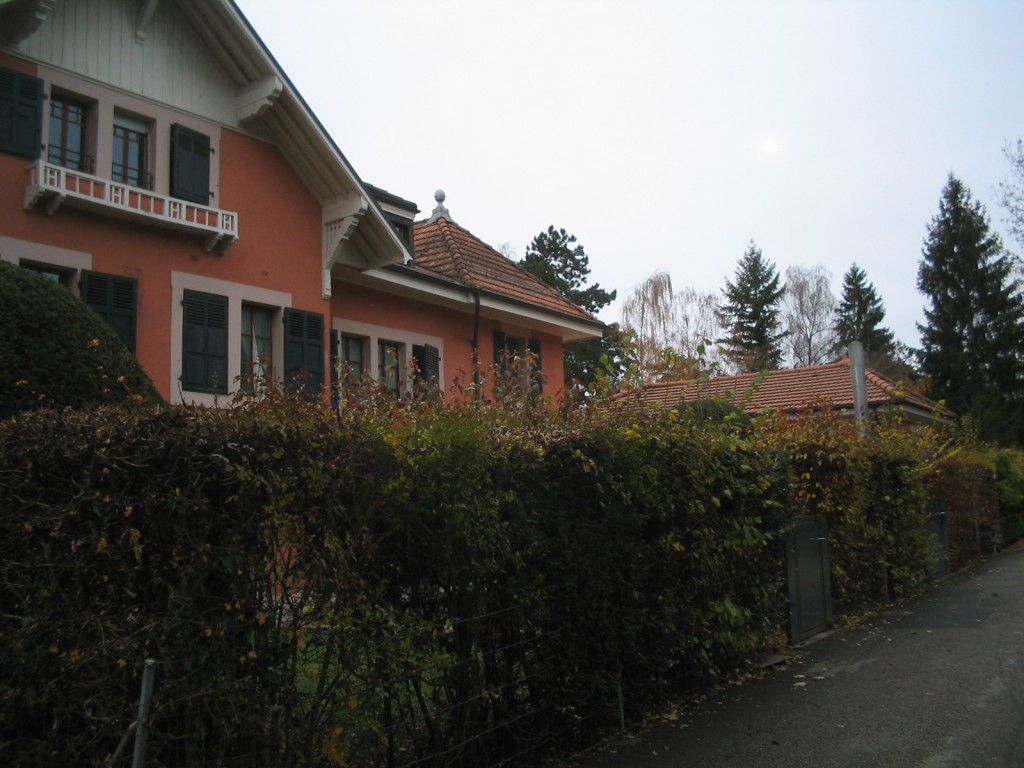
6 Chemin Fillion in Carouge
5. Rita – the judge’s dog – runs away from Valentine at the Promenade du Pin
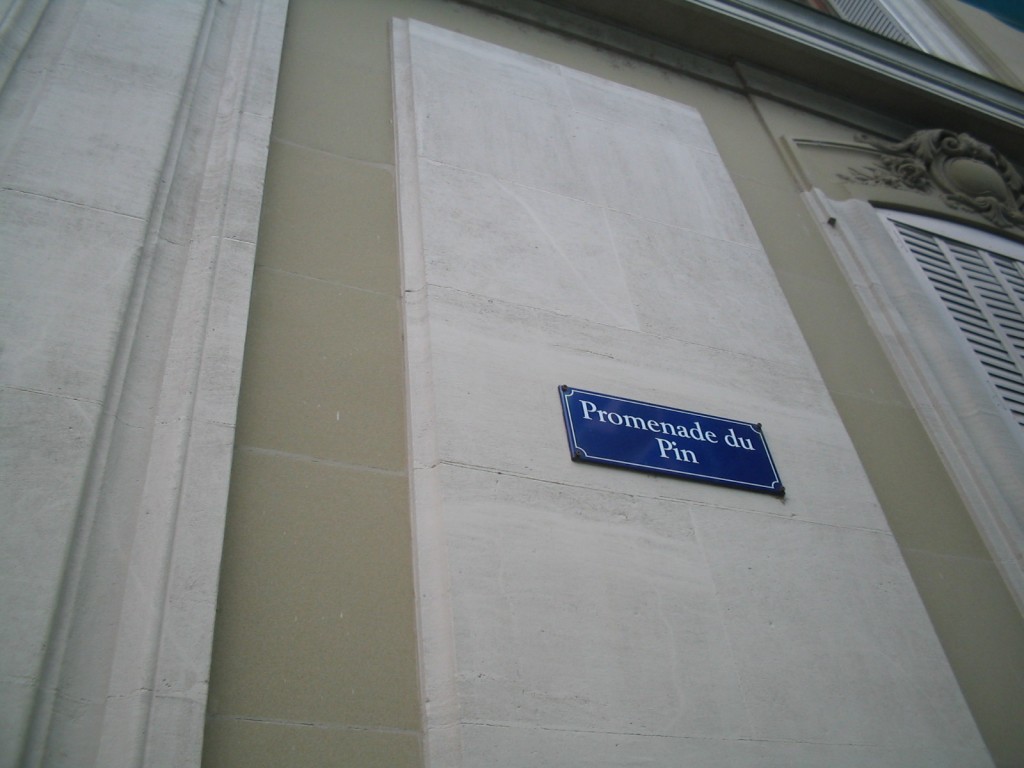
Promenade du Pin.
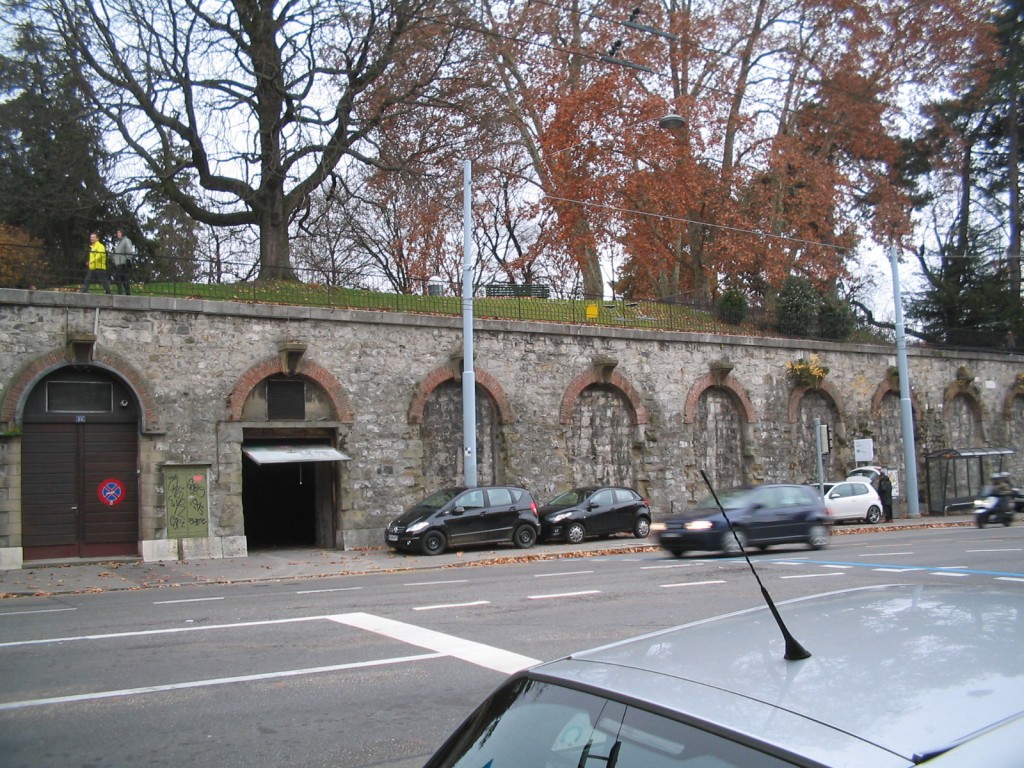
Promenade du Pin, which incidentally looks over Boulevard Emile-Jaques-Dalcroze and the Place des Casemates. This is the exact spot in which the huge poster of Valentine goes up – and down – later in the film.
6. Rita hides in the church of Saint Francois de Sales (23 Rue des Voisins):
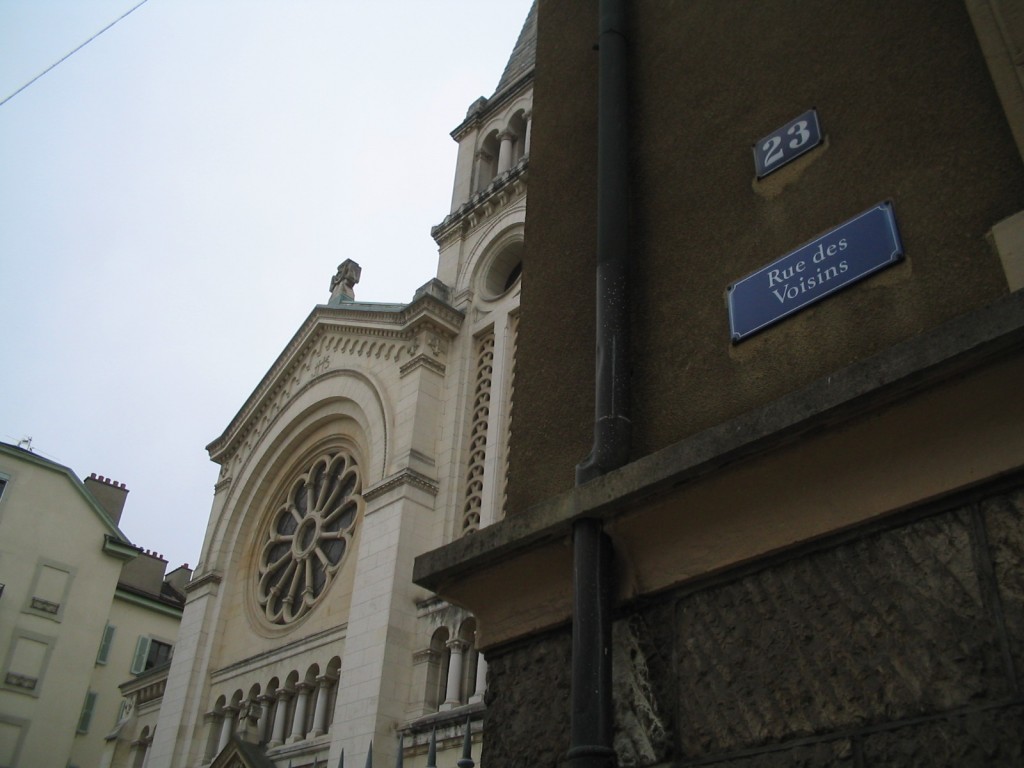
23 Rue des Voisins and the – beautiful – church of Saint Francois de Sales in the background.
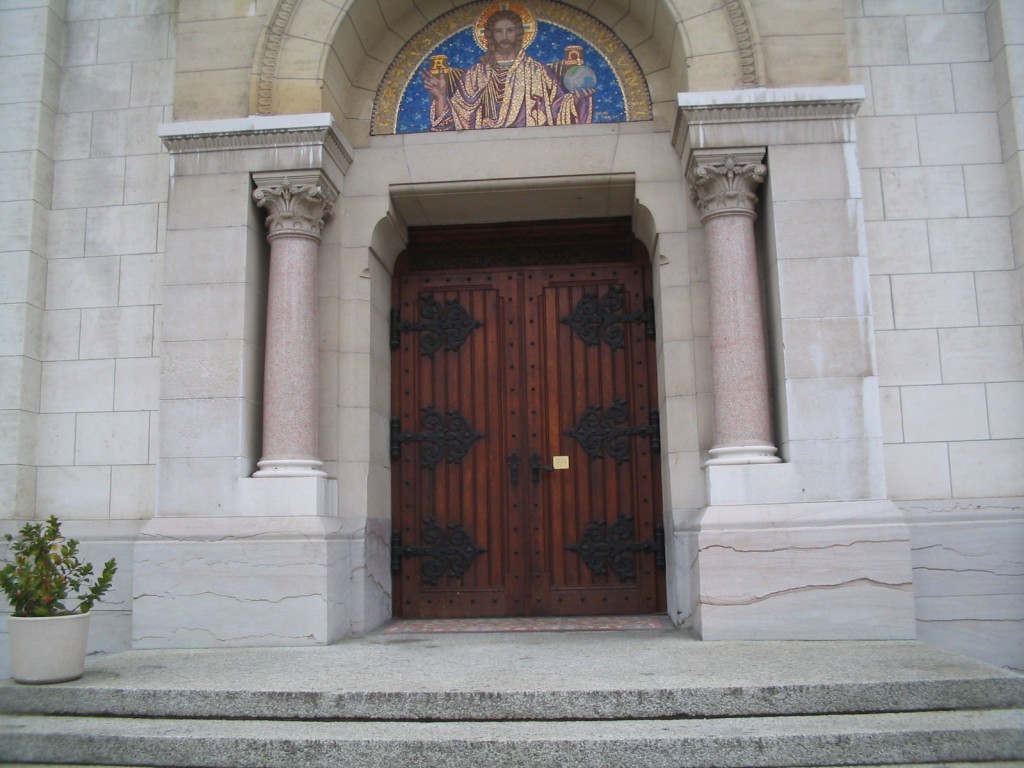
The entrance of the church of Saint Francois de Sales.
“I would like to say more about this scene. It looks so easy but it was quite difficult. In Red, particularly, we wanted the viewer to think backwards, to make associations with things he had already seen without noticing. For example, we keep the picture of the dog going into the church for quite a long time so the viewer remembers he has already seen it. A few minutes before, the heroine was in the same place, drinking mineral water, tired from doing her training. The same place.
Of course it’s not important; it’s just one of many shots. But we tried to build up these signs, particularly in Red, so the viewer would realise that what he sees here, he has already seen, and would register that in some part of his subconscious. Many of the signs will not get through to him, but we let them build up so that at least some do, so that he understands the principle” [Krzysztof Kieślowski 1994 masterclass, DVD extras].
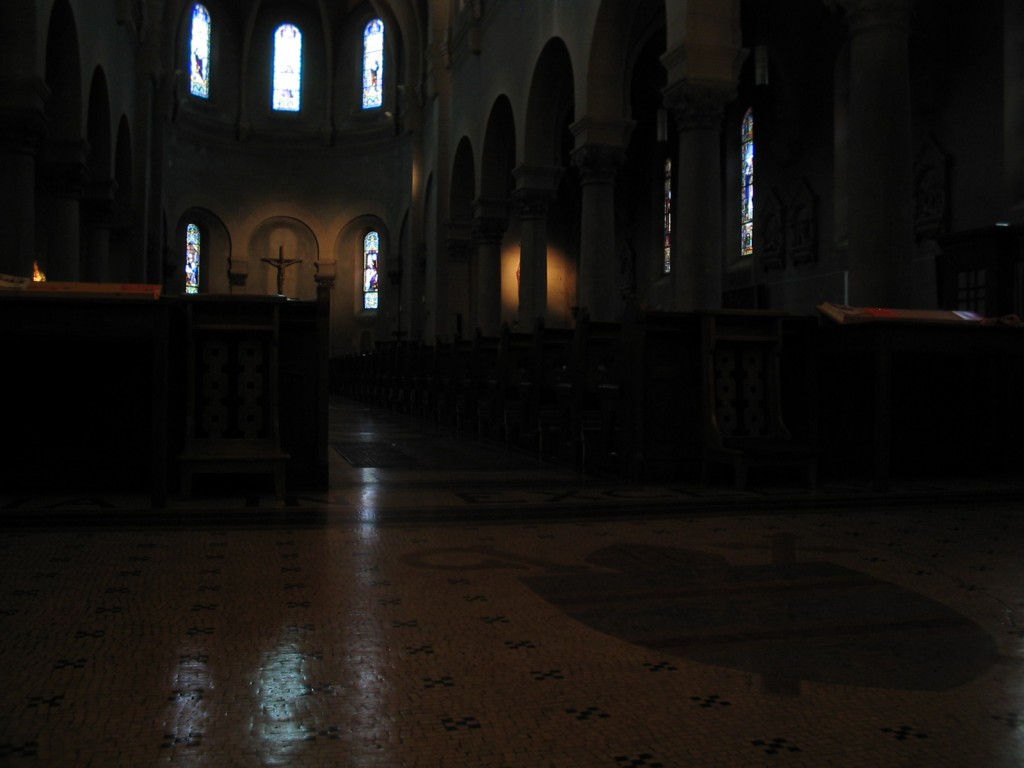
Inside Eglise Saint Francois de Sales. Valentine goes inside to search for the dog, briefly interrupting the service.
“This scene is also interesting because it shows us the character of Valentine. She interrupts mass, but it embarrasses her to interrupt something that might mean something to someone.” [Krzysztof Kieślowski, ibid.]
7. Valentine drives by Lac Léman (Lake Geneva) at the Quai de Cologny and turns right to Chemin Byron, continuing uphill
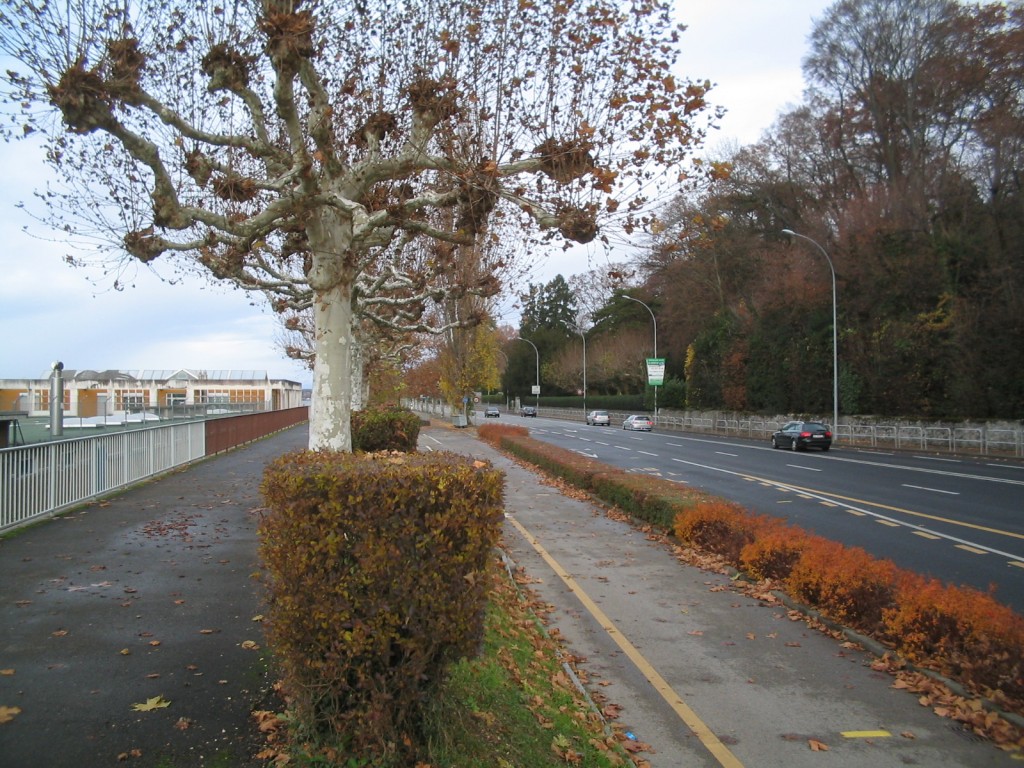
Quai de Cologny, Lac Léman (Lake Geneva).
8. The judge spies on his neighbours at 22 Chemin Charles Poluzzi
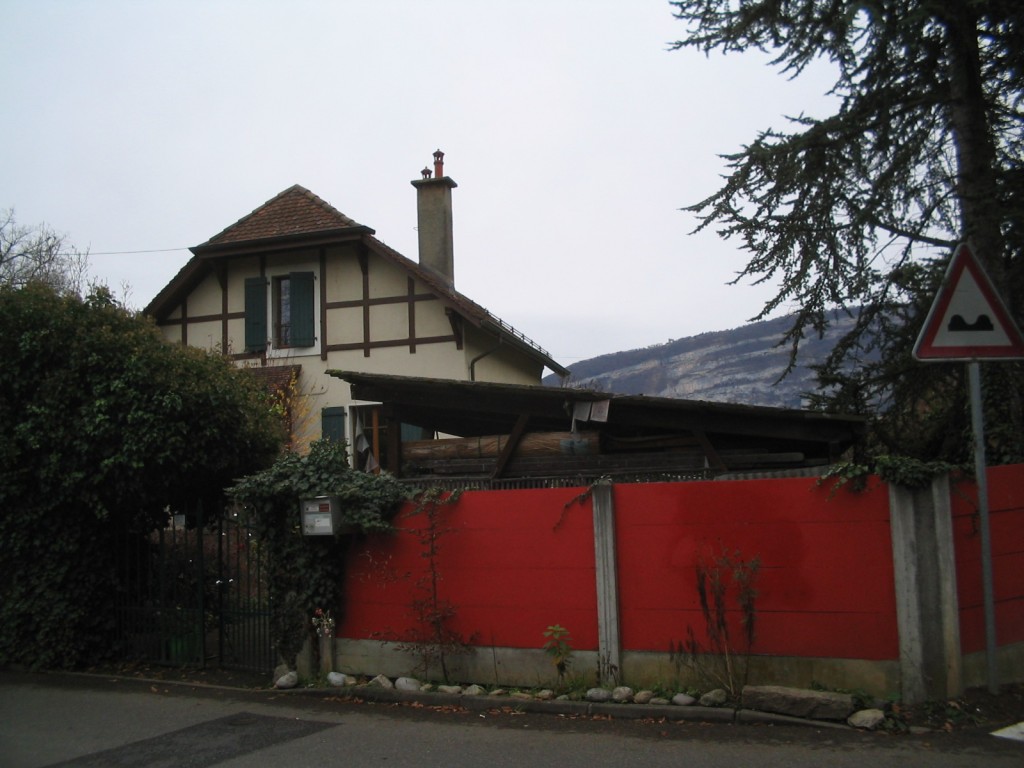
Chemin Charles Poluzzi, Carouge.
“If you look at Valentine’s life, nothing important is happening, but whoever is telling the story can take pleasure in penetrating into these people’s lives so you discover something new. You’re intruding. There’s something voyeuristic about it. You hear Valentine talk to her lover. The judge listens to his neighbours’ conversations. So you feel a bit voyeuristic”. [Irène Jacob, ibid.].
9. Université de Genève (University of Geneva)
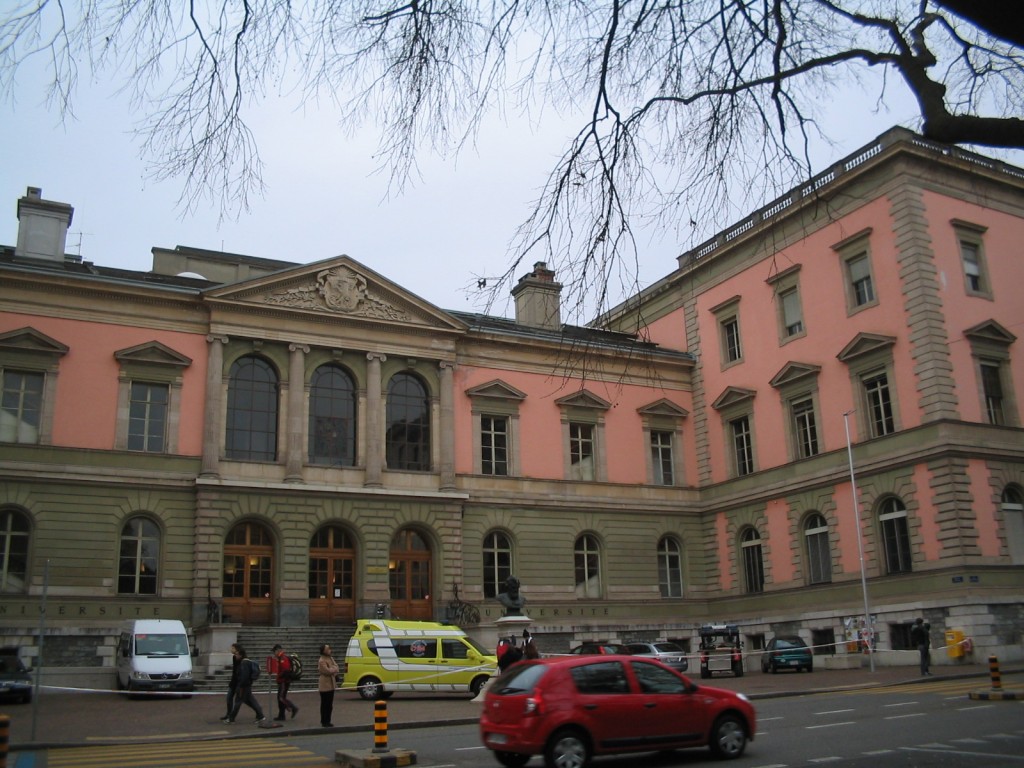
Valentine is a student at the University of Geneva. (Judging by the handrail, the steps, the shape of the wooden doors and the surrounding pavement, I’m almost certain that) Auguste celebrates passing his law exam at the steps of the main entrance of Uni Bastions, Rue De-Candolle.
“It’s an age when you talk about what you’re doing. You do things but you don’t really believe in them.” [Irène Jacob, ibid.].
10. The judge faces the residents of Pinchat (south-east Carouge) at the Palais de Justice (Place du Bourg-de-Four)
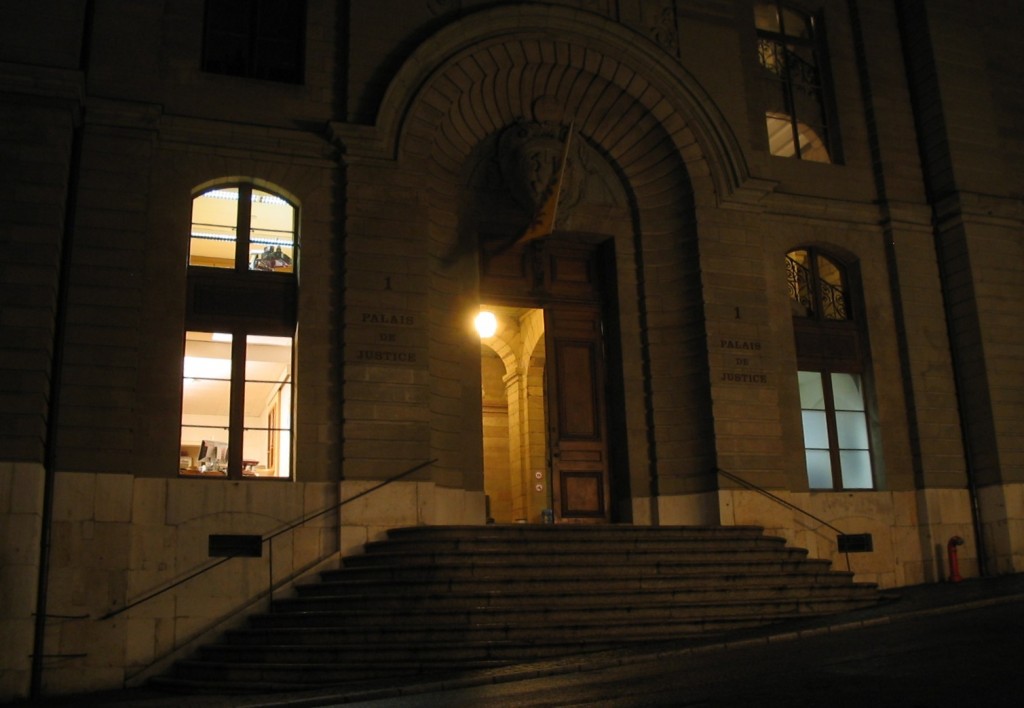
Palais de Justice, Place du Bourg-de-Four.
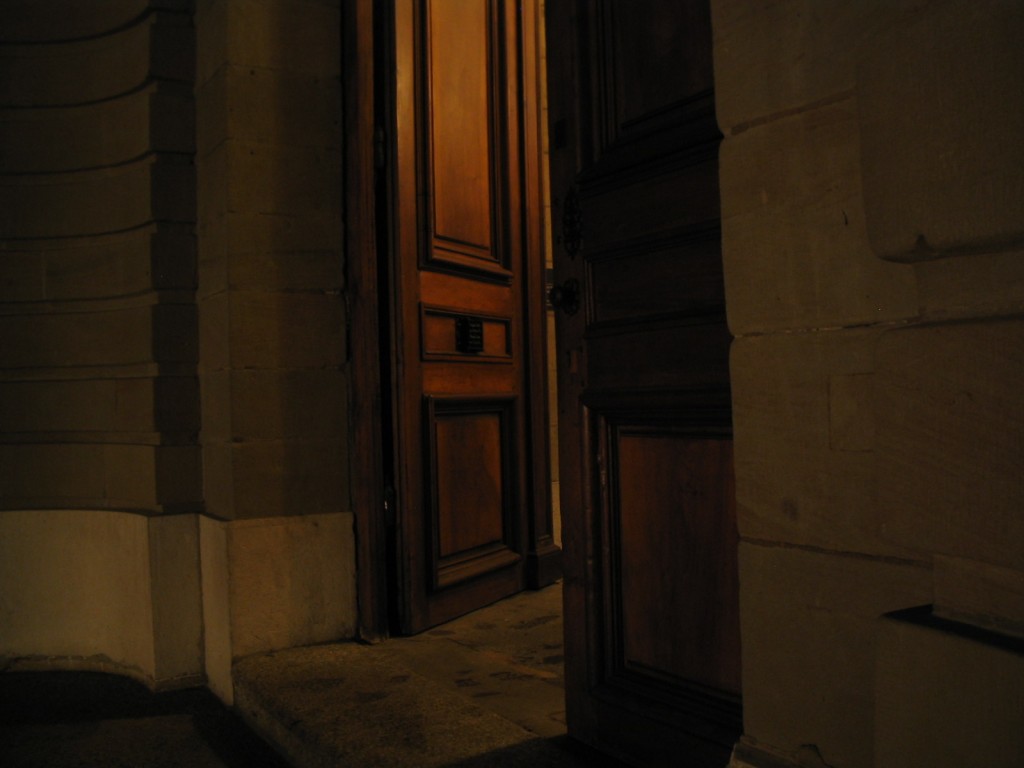
Palais de Justice, Place du Bourg-de-Four.
Valentine: If I had to go to court…are there still judges like you?
The Judge: You won’t go to court. Justice doesn’t deal with the innocent.
11. Auguste ties his dog at the Quai de Cologny by Lac Léman (Lake Geneva):
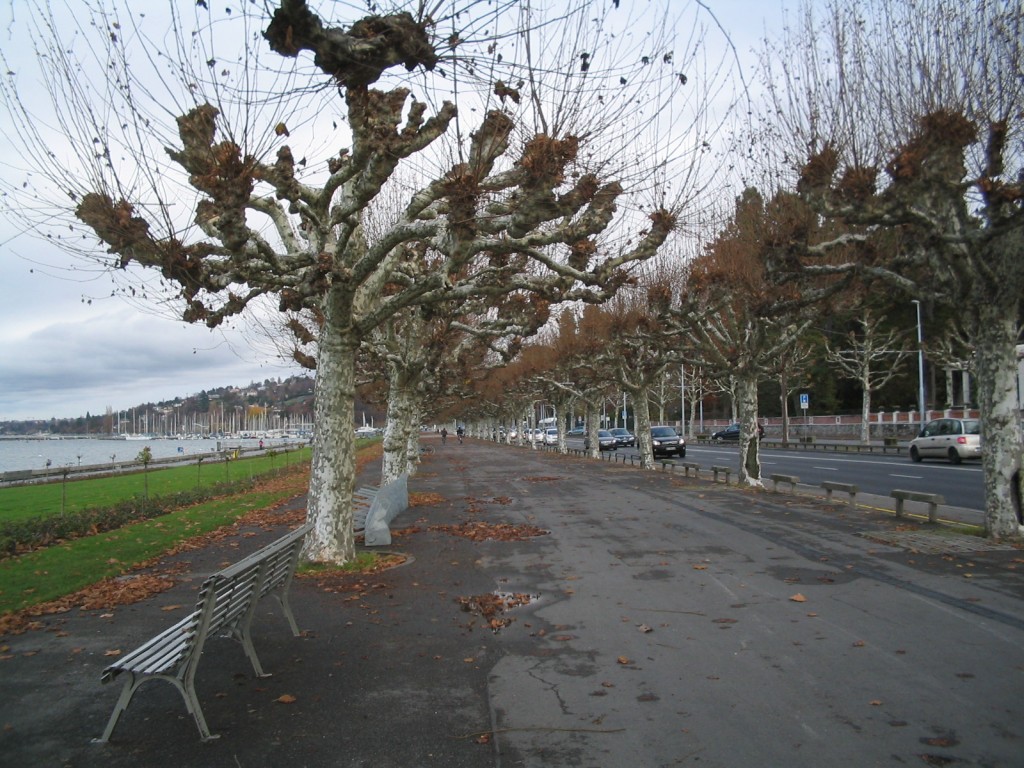
Quai Gustave-Ador at Lac Léman, and at the background (far left) Quai de Cologny
“There was the idea, with the film ‘Red’ being on the theme of brotherhood, that you might help someone or play an important part in someone’s life without knowing about it. […] It’s brotherhood in spite of one’s self.” [Irène Jacob, ibid.].
12. The judge stares at Valentine’s poster before turning right at the Place des Casemates
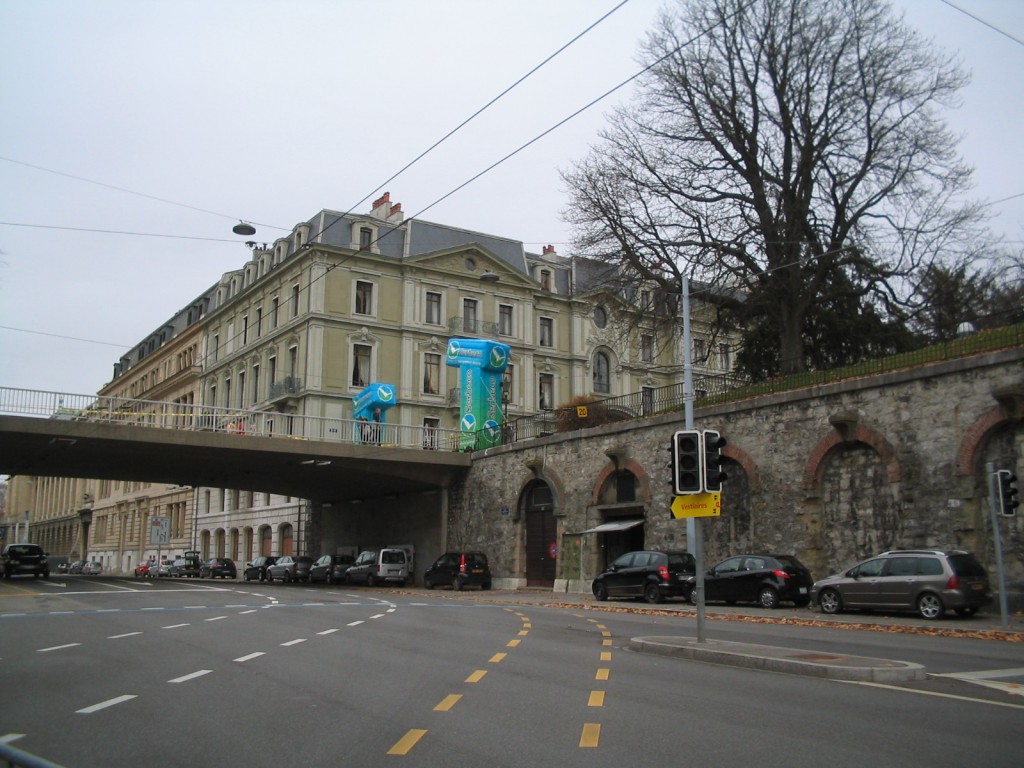
The corner of Place des Casemates and Boulevard Emile-Jaques-Dalcroze identically the same after 18 years.
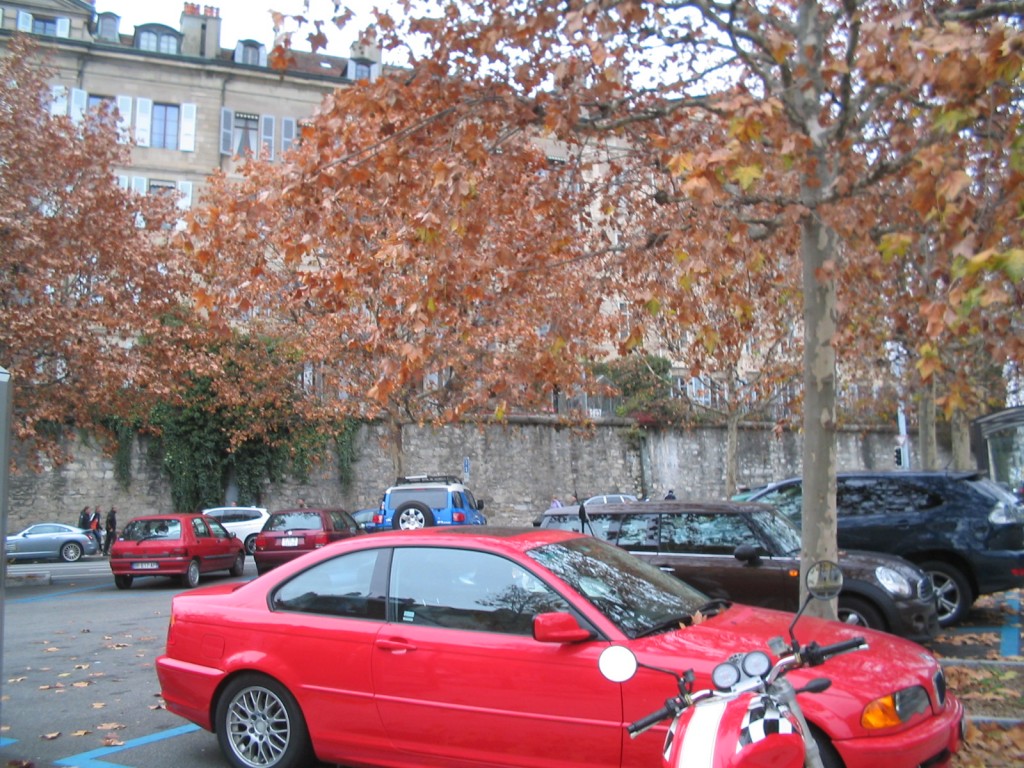
Place des Casemates.
13. Fashion Show II and Farewell: Grand Théâtre de Genève.
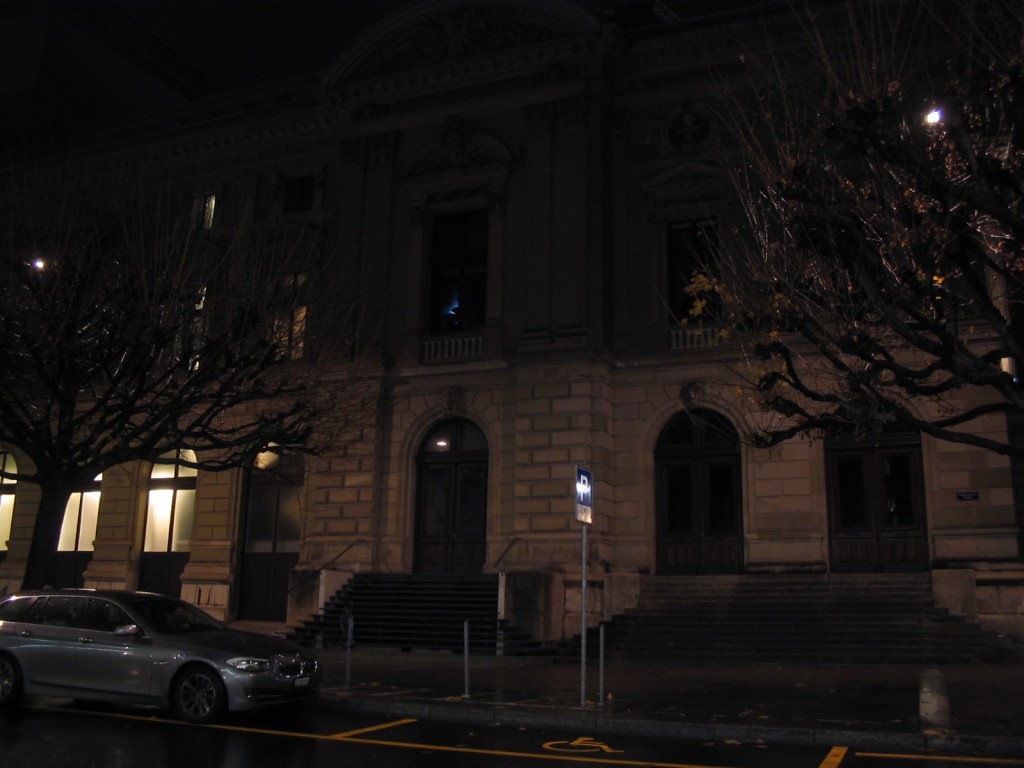
The side entrance to the Grand Théâtre de Genève, Boulevard du Théâtre. This is the exact spot at which the judge parks his Mercedes before attending Valentine’s fashion show.
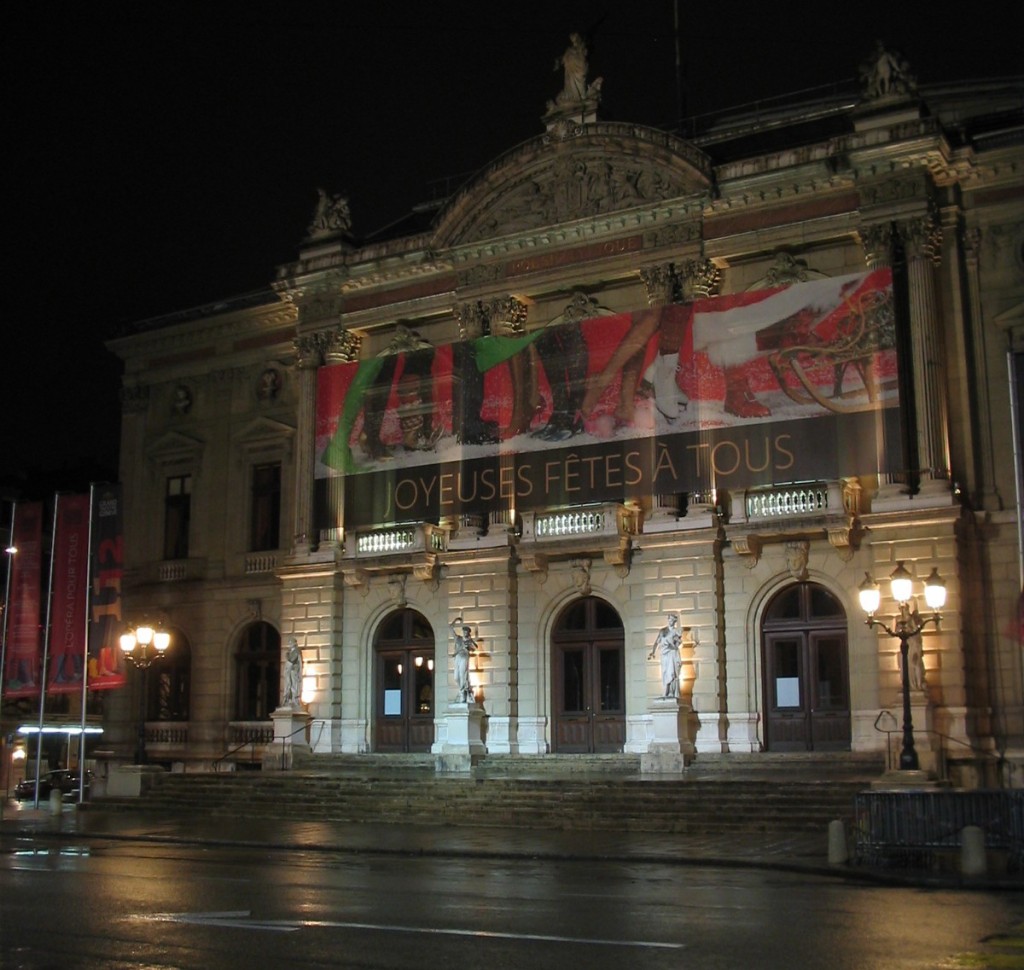
The Grand Théâtre de Genève where the Fashion Show takes place. After the show, the judge talks to Valentine about his past – about fate and guilt.
The Judge: Deciding what is true and what isn’t now seems to me…a lack of modesty.
Valentine: Vanity?
The Judge: Vanity.
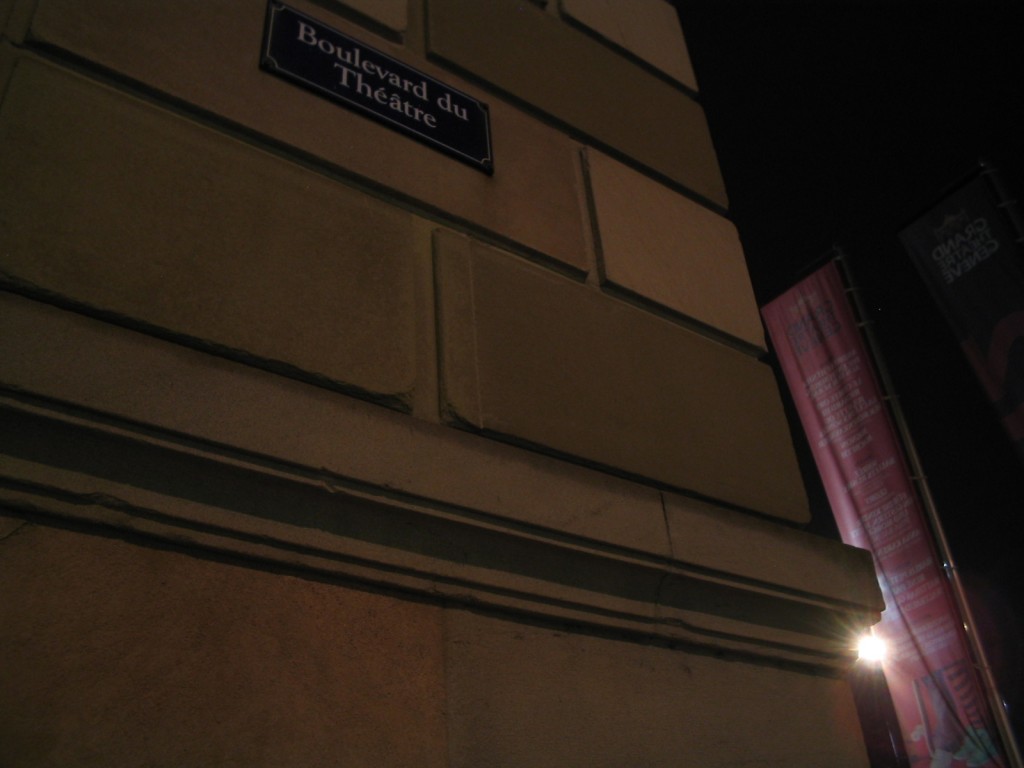
Grand Théâtre de Genève, Boulevard du Théâtre.
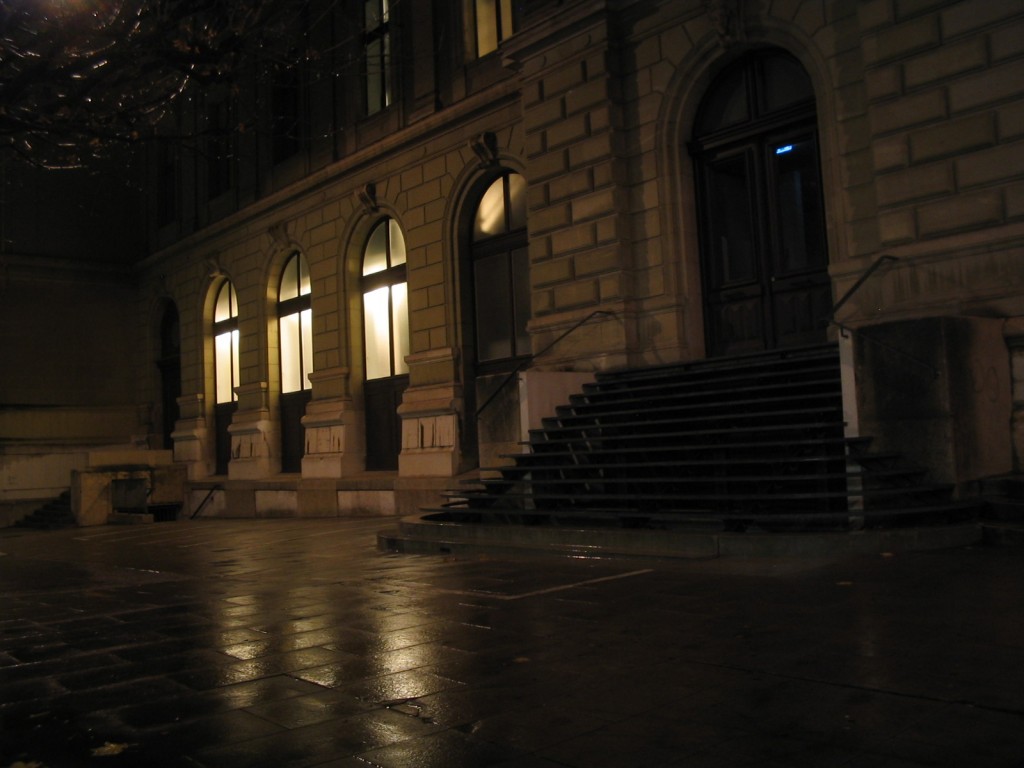
Grand Théâtre de Genève, Boulevard du Théâtre. Judge Kern gives Valentine a bottle of pear brandy and checks her ferry tickets as she is about to travel to England to see her boyfriend. They greet and he drives away. She notices an old lady trying to push a bottle into a recycling bin (a recurring scene in all three films of the Trilogy) and helps her.
The Judge: Leave. It’s your destiny. You can’t live your brother’s life for him.
Valentine: I love him. If only I could help.
The Judge: You can. Be.
Valentine: What do you mean?
The Judge: That’s all: be.
“It’s a film where things are possible. It’s possible to meet each other, to help each other. It’s not voluntarist. In life things are more subtle, more complicated. And it’s quite a hard film. […] In life you juggle so much and then what do you do with it all, without being completely pessimistic like the judge? There’s no answer for that. Something happens. It’s in spite of us, in the end… You can do anything you want, but if you don’t have love, it’s pointless. And you can try to help everyone, but if you’re not there, it’s pointless”. [Irène Jacob, ibid.].
On Location: Revisiting ‘Trois Couleurs: Rouge’ – a Tribute to Krzysztof Kieślowski
December 2011
All photos: © Roman Gerodimos | December 2011
Recommended Reading:
D. Stok (1994), Kieslowski on Kieslowski, Faber & Faber
G. Andrew (1998), The ‘Three Colours’ Trilogy, BFI
S. Zizek (2001), The Fright of Real Tears: Krzystof Kieslowski Between Theory and Post-Theory, BFI
A. Insdorf (2002), Double Lives, Second Chances, Miramax Books
M. Haltof (2004), The Cinema of Krzysztof Kieslowski: Variations on Destiny and Chance, Columbia University Press
J. Kickasola (2004), Films of Krzystof Kieslowski, Continuum
Recommended Listening:
Z. Preisner (1994), Trois Couleurs: Rouge, Virgin Records
Z. Preisner (1998), Requiem for my Friend, Erato
Recommended Links:
http://www.youtube.com/watch?v=nh5P3z6o968
I hope you enjoyed this photo-essay. This content is free, but feel free to…

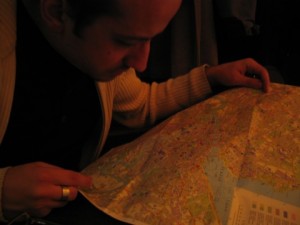
Really amazed with all the hard work you’ve put into this one. Well done and keep them coming! 🙂
🙂
Thank you for this amazing work. I love Kieslowski. Greetings from Argentina.
Thank you Ana! Greetings from snowy London!
Hi there
Great, all I have looking for, so many Years. Thank you very much!
Marc
This is absolutely beautiful; thank you for taking the time, Roman.
Thank you Michael!
Hello Roman,
I cannot think of another film that has caused me such pleasure, here in a gray misty suburb of Seattle, WA. Your work presenting these locations reflects the time and depth you have expended; bravo.
Thank you, these many years on.
Tom
Tom,
Thank you for taking the time to leave a comment and for your kind words – glad to hear that you enjoyed the photo-essay.
It’s been almost 20 (!) years since Kieślowski’s trilogy but these films are amazingly powerful and still relevant.
By the way, not sure if you’ve already been to Geneva, but it’s definitely worth visiting.
Best
Roman
Thank you very much. The locations of valentine’s flat and the cafe and the night scenes seemed and felt so beautiful and personal when i watched the movie. Hoping to visit Geneva as soon as i can before they rebuild those places. Once again..thank you
Thanks for visiting and commenting Saad. Geneva is definitely worth the visit. While the building of Valientine’s flat has changed, the neighbourhood is still beautiful.
Roman,
I have just re-watched ‘Rouge’ after what must have been 5 years since the last time. Having lived the past 4 years in Geneva, I partly recognized some of the areas where ‘Rouge’ was shot, and thought I recognized the street where my previous apartment was.
Thank you for confirming it, I now feel amazed that I was actually living at the exact same location of Valentine’s flat in what is one of my most favorite films ever!
Thanks,
Lennert
Lennert, wow, that’s amazing! what a great coincidence! Thanks for visiting and leaving a comment!
Roman
Thank you so much for posting this! I will be visiting Geneva soon, and with Three Colours Red being one of my favourite films, this has been hugely beneficial!
I’m sorry but my english is very bad. My replay will be in French. Now, je viens de voir “Rouge” my favorite Kieslowski’s film, pour la 6ème fois sur la chaîne France 2 et c’est magique, parce je habite a Carouge GENEVA et je me donne compte que Valentine’s flag est a 200 m. de là où je habite maintenant. Magique, magnifique et merci Roman. Je suis de Paraguay et je suis à Geneva depuis 2006. Merci encore.
🙂 Ruben, thank you for taking the time to leave a comment. I’m glad you enjoyed the photo-essay.
Hi, Roman,
that was really interesting. I’m very fond of “Red” and was really curious to find out the locations of the film. I’d like to go to Ginevra to have a look, also if, I’m afraid, many places have been changed and (as I can see from Google map) the turn into the Byron Street is allowed only to the residents. What I have not completely understood is why this beautiful corner has been used if totally away from Carouge where the house of the judge is supposed to be … But in this little steep road there are some of the most beautiful scenes of the movie, such as the one when, at sunset, Valentine is coming back crying from the judge’s house. And is it not possible to find out the house of the man with the “japanese telephone” who is … controlling the heroin traffic in Geneva?
Ciao Giovanni
Sorry for taking so long to reply.
Yes, I was also very surprised by how far away from all the other locations the turn to Chemin Byron was, but as you say it really works dramatically.
Unfortunately I couldn’t find the other house that you mention.
I have an exam tomorrow of religion. We have to link trois couleurs: rouge with the story of Kain and Abel. Could you help me? And I love the work and effort you put in this!
Ine dewitte
I first watched Three Colors: Red more than ten years ago. I was fascinated by its thematics and aesthetics as I was fascinated by Kieślowski’s The Double Life of Véronique and Three Colors: White. The fact is that, some years after watching the movie, I moved to Geneva where I lived very close to some of these locations. I only noticed this after a recent rewatch! Thanks for revisiting some of the Red’s locations. Your post brought me some fond memories of my time in Geneva and it has some of my favorite lines in the movie.
Cheers!
Thanks for visiting the site! Glad you liked the photo-essay
There is something important to add : the chemin Fillion was the a private way belonging to the family of Jane Fillion who inspired a mythical book, “Belle du Seigneur”, it is where the love began.
Thank you. I’m fascinating by this piece of information – including the story of Albert Cohen – but I’m also intrigued by the identity of this commentator.